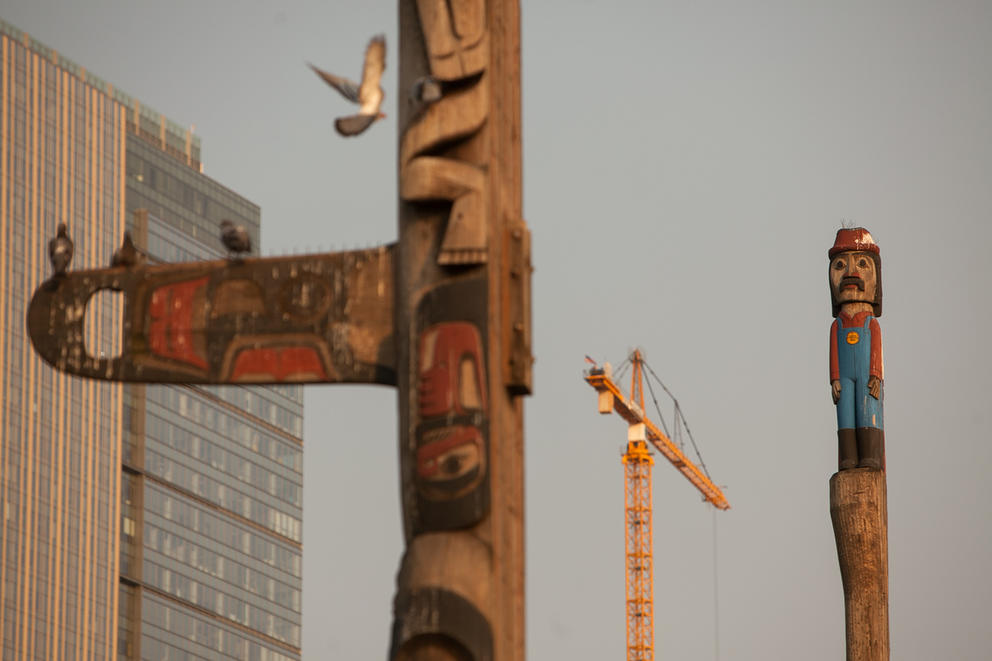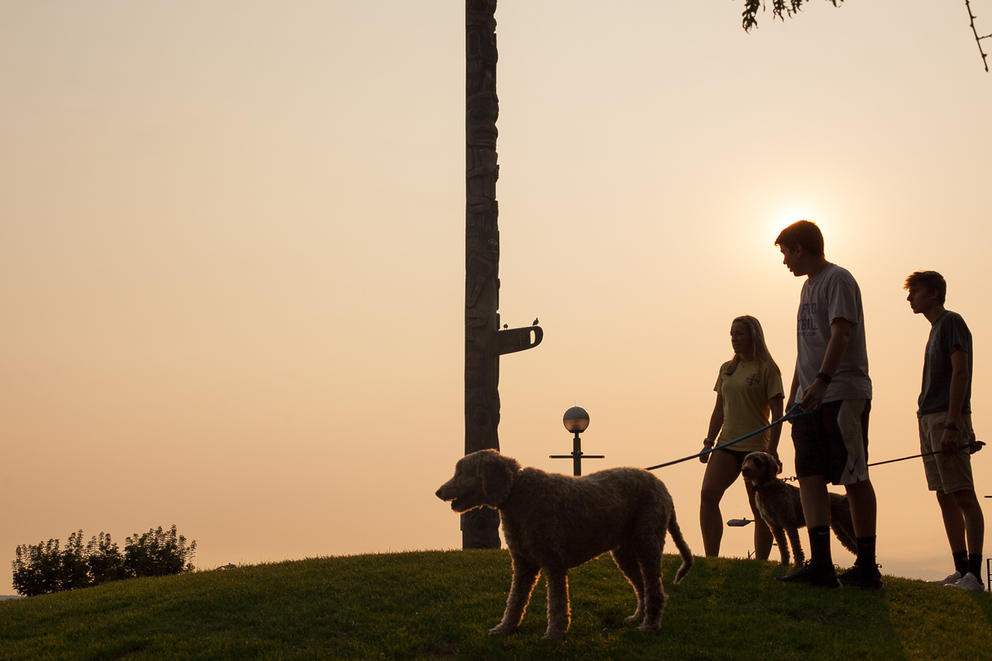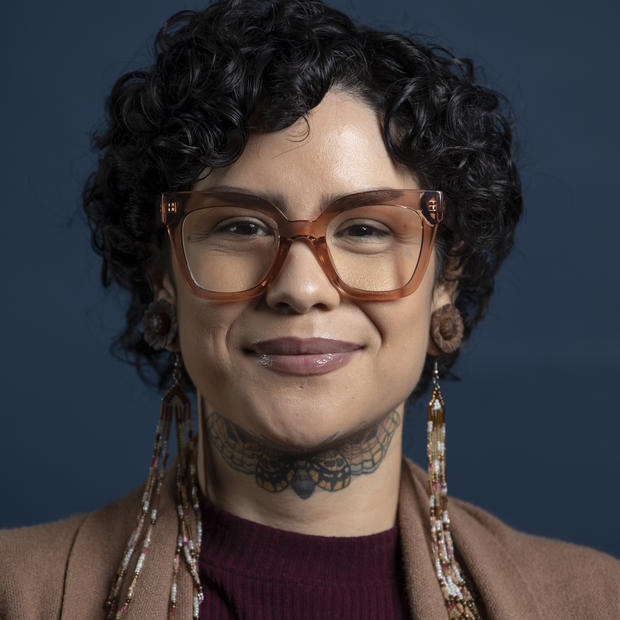“They don't tell a story about me or my people, and it really makes me feel less-than because we are being represented by totem poles and teepees and that's just not who we are as Coast Salish people,” said Puyallup Council member Annette Bryan. “We are people who use storytellers, story poles, welcoming figures like the one that's in the city of Tacoma done by a Puyallup tribal member, and we are people who lived in longhouses along the waterways, so I just feel like it's really important to tell that story.”
As the 2018 plan for renovations of Victor Steinbrueck Park have restarted, the push for the poles to be removed, relocated and replaced with culturally appropriate and historically accurate artwork has been reinvigorated.
The renovations helped start the conversation about the appropriateness of having the poles there. Seattle City Council members Debora Juarez, Sally Bagshaw and a group of Indigenous leaders met and agreed that the two totem poles that Steinbrueck commissioned and installed in the park in 1984 should be removed and relocated to the Museum of History and Industry to honor their historic significance. But the pushback was loud.
Victor Steinbrueck’s son Peter was among the loudest in opposition, claiming that “It was an act of love and compassion that the poles came to be,” according to Crosscut reporting in 2018. Steinbrueck argued that the two poles were markers of friendship between communities because Marvin Oliver, a well-known and respected Quinault Nation carver, was believed to have designed them. In 2018, Oliver seemed to distance himself from the poles by telling the Pike Place Market Historical Commision that while he was commissioned to do the job, “This is Victor’s pole, it’s not my pole.” Oliver passed on in 2019.
A totem pole at Victor Steinbrueck Park near Pike Place Market on Friday, May 6, 2022. Local leaders, including Council President Juarez, Esther Lucero of SIHB, Johnpaul Jones architecture, Chris and Pamela Stearns of the King County Native American Leadership Council, local Native artist Louie Gong, and others., want the totem poles taken down, as they were not designed with input from local tribes and do not represent Coast Salish Native culture. (Amanda Snyder/ Crosscut)
Native inspired or inspired Natives
James Bender, a non-Native man who was also commissioned by Steinbrueck to work on the poles, said he never worked with Oliver. In fact, Bender told Crosscut he was the one in charge of the project, working only with Steinbrueck on the design and carving both poles himself.
Bender specializes in what he told Crosscut and what is shared on his website as “Northwest Coast Indian art” representative of Northwest Coast Native Nations in Canada and Alaska, but there is no mention of him being non-Native on his website. Under the Indian Arts and Crafts Act, it is illegal for non-Native people to sell their artwork without being clear that they themselves are not Native.
The saturation of this style of Indigenous art in Washington has also led many non-Natives who live on Coast Salish land to assume that totems are part of local Coast Salish cultures. For Andrea Wilbur-Sigo, a member of the Squaxin Island Tribe and seventh-generation traditional Coast Salish carver, this has resulted in her traditional work not being accepted. She has even been told it wouldn’t sell.
“I had to argue that and say, ‘No, this is who we are,’ ” Wilbur-Sigo told Crosscut. “This is what I do and what we've always done.” Her first memory is selling beadwork to an elder when she was just 3 years old. “Every piece is an educational piece to teach people who we are, our stories.”
Colleen Echohawk, an enrolled member of the Kithehaki Band of the Pawnee Nation and a member of the Upper Athabascan people of Mentasta Lake, is the CEO of Eighth Generation, a Seattle-based Indigenous art and design brand owned by the Snoqualmie Tribe. She shared a similar story about an older white woman who picked up a piece of traditional Anishinaabe art at a focus group and said, “This doesn’t look like Native art to me.”
“That is a problem because mainstream society has been influenced by culturally appropriated art, white supremacy has dictated what is seen as Native art and what is not Native art, and we have a general public who's very confused by it,” Echohawk said. She sees bringing Native art into people's lives and homes as a way to start changing the hearts and minds of people who hold biases about Native people and art.
Legacy of oppression
Wilbur-Sigo also explained how passing off other culture’s art as local Native creations creates an economic issue for Native artists. Indigenous people make just eight cents for every dollar their white counterparts make. When people purchase Native-inspired art, in addition to not properly sharing Indigenous stories and traditions, the artists who created it are essentially poaching customers from local Indigenous artists.
Bender doesn’t agree. “The jobs are there and somebody's gonna do them,” he told Crosscut. “If they're good enough, they'll get some jobs. We all have to make a living and I choose to make a living doing art. Specifically Northwest Coast art, and I do work that I consider very high quality.”
Wilbur-Sigo acknowledges that Bender’s work on the Pike Place poles is high-quality. She called him a wonderful carver who does beautiful work, but this doesn’t change the fact that authentic traditional Native art is being passed over for Native-“style” or -“inspired” art that, while pleasing to look at, has no Native roots.
“The roots are something that you're really born with,” Wilbur-Sigo said. “Nobody can take those from you.”
It has gotten better for Wilbur-Sigo since she was first told 26 years ago that her art wouldn’t sell. She is currently working on three traditional welcome figures that will be installed on
Olive Way and one on Pine Street at the Washington State Convention Center, and one that will be at the intersection of Second Avenue and Yesler Way in front of ?ál?al, Chief Seattle Club’s new affordable-housing development. She hopes that these welcome figures will contribute to educating the greater community about who the Coast Salish people really are.
“When we're not able to do our own work, and we're competing with people that aren't from here or people that aren't Native, it takes a toll not only financially, but I will say it's a cultural struggle too,” Wilbur-Sigo said.
For many Indigenous people, Native-inspired art is seen as a continuation of the theft of land, labor and culture. This perpetual legacy of oppression is also maintained through architecture, according to Seattle City Council President Debora Juarez of the Blackfeet Nation. She believes maintaining power over the architecture and art installations in any city has been and continues to be a colonial tool to keep certain people out, to erase history, or to celebrate someone else’s history.
“Taking up that space, protecting it already started with the assumption that they have the power, the authority, the access, the privilege,” Juarez said. “I would say it would be an act of compassion and love by Mr. Steinbrueck to look at the history and honor the Salish people. Not digging in your feet to defend your family's name.”
Celebrating the Coast Salish
Juarez was pivotal to the initial push in 2018 to have the totem poles removed, which became a broader analysis of Native art in the city. She sponsored a bill that directed the city’s Office of Arts and Culture to review and make recommendations about all the Native art on city-owned land in Seattle. A list of artworks on city-owned land referencing, honoring or displaying Native American culture has been created, but so far there has been no analysis of how many of these were created by non-Natives or by local Coast Salish Native people, and no recommendations have been made.
According to Juarez, this is something the newly formed Indigenous Advisory Council, which will advise the mayor, city council, and city departments on anything directly affecting Indigenous populations, will likely address once all nine positions have been filled.
Seattle City Council member Andrew Lewis chairs the committee on Public Access and Homelessness, which oversees the city’s parks, among many other things. Lewis said Seattle Parks and Recreation were given direction and funding by the committee, but due to the pandemic, the Victor Steinbrueck Park renovations that will now include the removal of the poles and installation of new Coast Salish art haven’t been implemented.
According to Cate Oliver, senior public relations specialist for the city, this isn’t entirely true. Although the Commission approved the Victor Steinbrueck Park renovation project in September 2019, which would remove the totem poles during the renovation, a condition of the approval was that the poles were reinstalled before Victor Steinbrueck Park is reopened. Removal of the poles would require an application and review of the application at a public meeting. When asked whether public meetings that happened in 2018 would apply to this process, Oliver could not clarify.
Bender was taught to carve in traditional Northwest Coast style at the University of Washington from two other non-Native men, Bill Holm and Duane Pasco, as were other Native and non-Native students. He sees no issue with what he creates or how it is categorized.
And although Wilbur-Sigo comes from a long line of carvers, her mentor, Loren White, is also a white carver. The difference, according to Wilbur-Sigo, is that White was taught by Wilbur-Sigo’s elders and has used those teachings to help revitalize the craft with other tribal members.
Because traditional art forms were impacted by laws banning Indigenous religion and sacred ceremonies, which didn’t begin to change until the 1970s, people like White who give back to the Native people whose cultures they have learned from and appreciate are cherished.
Wilbur-Sigo acknowledged the potential of good intentions in the past, but says there is no place for non-Native carvers making a living from Native-inspired art anymore. Now that more prominent Native carvers are being acknowledged, she believes it’s time for non-Native people to find their own cultural roots.
“It just all goes back to being honest about who we are and where we come from, and what the actual meaning is to the actual artist,” Wilbur-Sigo said. “Reading that he’s calling his work Northwest Coast Native art is pretty gutsy. That’s misrepresentation at its finest.”
Correction: The original version of the story shared information from Council member Lewis that the Pike Place park totem poles would be removed and replaced with Coast Salish art. According to new information from Pike Place Market Historical District, Seattle Parks and Recreation must still submit an application for the removal to be considered.
Get the latest in election news
In the weeks leading up to each election (and occasionally during the legislative session), Crosscut's Election newsletter will provide you with everything you need to know about races, candidates and policy in WA state.






